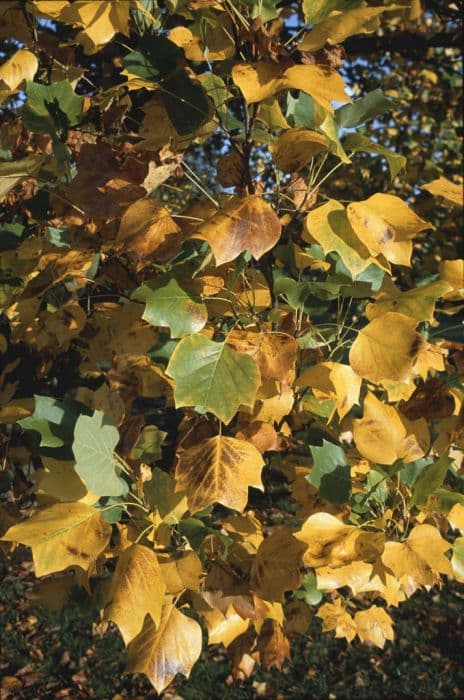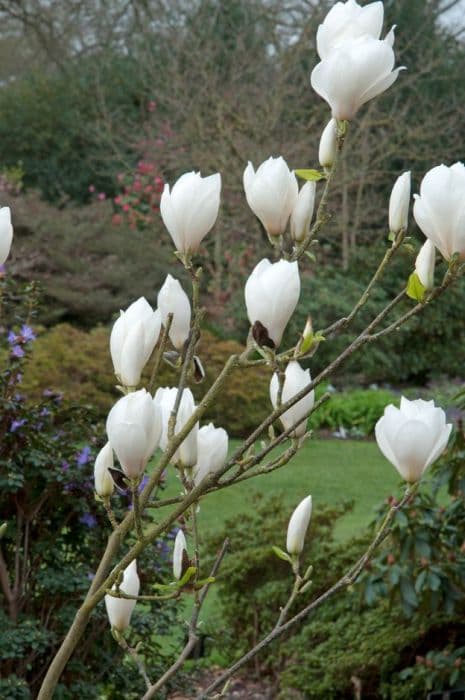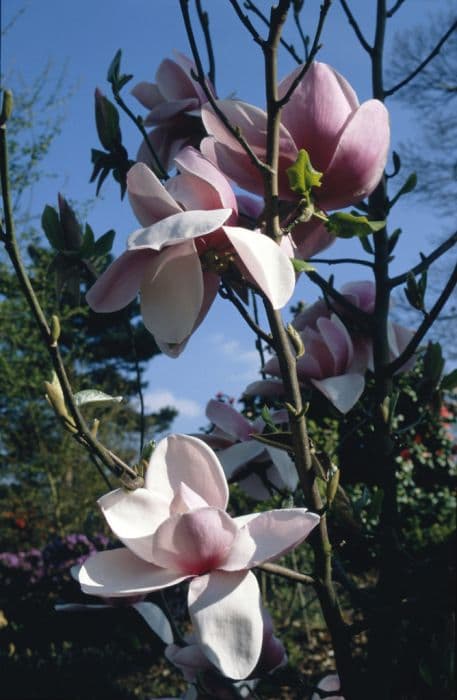Magnolia Magnolia 'Theodora'

ABOUT
Magnolia 'Theodora' is a striking plant that showcases large, lush blooms. The flowers of this magnolia are typically displayed before the foliage in the spring, offering a dramatic floral display. They are cup-shaped and have a creamy-white to pale pink color, becoming more vibrant at the base. Magnolia 'Theodora' blooms emit a subtle, sweet fragrance that can be noticed when in close proximity to the plant. The leaves are dark green and have a glossy texture, adding to the plant’s overall lush appearance. They are broad and can provide a dense canopy, which creates a nice backdrop for the blossoms when they appear. After the flowering season, the leaves continue to add visual interest through the summer and into the fall. The bark of Magnolia 'Theodora' is smooth and gray, offering a muted contrast against the brighter flowers and leaves. The overall shape of the plant is typically rounded, contributing to the plant's elegant and classic aesthetic. The structure of its branches tends to be quite strong and can create a symmetrical silhouette in the landscape. Though it is important to note that the size of the plant can vary, discussions of its exact measurements are excluded from this description. Overall, Magnolia 'Theodora' is a beautiful plant known for its showy flowers and appealing form, making it a favorite among gardeners looking to add a touch of elegance to their landscapes.
About this plant
 Names
NamesFamily
Magnoliaceae
Synonyms
Theodora Magnolia
Common names
Magnolia 'Theodora'.
 Toxicity
ToxicityTo humans
Magnolias are not commonly listed as toxic to humans. Magnolia 'Theodora' should not pose a significant risk of poisoning if ingested. However, as with many plants, consumption of non-food parts can lead to discomfort or an adverse reaction based on individual sensitivities. If someone experiences symptoms after ingesting any part of the magnolia, it is advisable to seek medical attention.
To pets
Magnolias are generally considered to be non-toxic to pets, including Magnolia 'Theodora'. It is not likely to cause poisoning in animals if they ingest parts of the plant. However, individual animals might have sensitivities, and eating large quantities might cause gastrointestinal upset such as vomiting or diarrhea. If your pet shows signs of distress after consuming any part of a magnolia, it's recommended to consult a veterinarian.
 Characteristics
CharacteristicsLife cycle
Perennials
Foliage type
Deciduous
Color of leaves
Green
Flower color
Pink
Height
20-25 feet (6-7.6 meters)
Spread
15-20 feet (4.5-6 meters)
Plant type
Tree
Hardiness zones
5-9
Native area
Southeastern Asia
Benefits
 General Benefits
General Benefits- Aesthetic Appeal: Magnolia 'Theodora' offers large, fragrant flowers that are a visual and olfactory delight in springtime gardens.
- Landscape Versatility: Fits well in various landscape designs, ranging from formal to cottage gardens.
- Wildlife Attraction: The flowers provide nectar for pollinators like bees and butterflies in the ecosystem.
- Shade Provider: Mature trees can offer a significant amount of shade, creating a cooler microenvironment.
- Seasonal Interest: Besides spring flowers, it can offer attractive foliage in summer and interesting seed pods in autumn.
- Durability: Known for being a hardy plant that can withstand a variety of soil conditions and weather extremes once established.
- Low Maintenance: Requires minimal pruning compared to other flowering trees and has no major pest or disease problems.
- Privacy: When planted in a row or cluster, it can serve as a privacy screen from neighbors or street traffic.
 Medical Properties
Medical PropertiesThis plant is not used for medical purposes.
 Air-purifying Qualities
Air-purifying QualitiesThis plant is not specifically known for air purifying qualities.
 Other Uses
Other Uses- Artistic Inspiration: Magnolia flowers, with their striking appearance, often inspire artists and photographers, making them a popular subject for paintings, drawings, and floral photography.
- Perfumery: The sweet and pleasant fragrance of Magnolia 'Theodora' can be used in the production of perfumes and scented products.
- Culinary Ingredient: In some cultures, the petals and buds of Magnolia are pickled, used as a spice, or added to dishes for a unique flavor.
- Fabric Dye: The bark and flowers of some Magnolia species can be used to make a natural dye, which may be used in textile coloring.
- Wedding Decorations: Magnolia flowers and leaves are popular choices for creating elegant wedding bouquets, centerpieces, and venue decorations due to their large size and beauty.
- Educational Tool: Botany educators may use the plant as a specimen to teach about plant biology, flower anatomy, and pollination mechanisms.
- Cultural Symbols: Magnolia flowers are deeply intertwined with Southern culture in the United States and can be used in cultural festivals and artistic representations to symbolize hospitality and grace.
- Homemade Cosmetics: The flowers and leaves, when infused into oils or waters, can be ingredients for homemade lotions or toners for their potential soothing properties.
- Garden Design: As a specimen tree, Magnolia 'Theodora' adds architectural interest to landscape designs and can be used to create focal points in gardens.
- Religious Ceremonies: In some traditions, the magnolia flower symbolizes purity and nobility and can be used in various religious and ceremonial decorations.
Interesting Facts
 Feng Shui
Feng ShuiThe Magnolia is often associated with purity and nobility in Feng Shui, and it can be used to introduce a sense of tranquility and grace to a space. To enhance the positive energy or chi in your home, place Magnolia flowers or plants in the garden in the Southwest sector to promote love and romantic happiness, or in the East to support family harmony and health.
 Zodiac Sign Compitability
Zodiac Sign CompitabilityThe Magnolia is not used in astrology practice.
 Plant Symbolism
Plant Symbolism- Perseverance: Magnolias are known for their ability to withstand harsh conditions, thus symbolizing endurance and steadfastness.
- Femininity: Their delicate and graceful appearance often represents femininity and gentleness.
- Dignity: The stately growth habit of magnolia trees embodies dignity and poise.
- Nobility: Magnolias are frequently regarded as a sign of nobility and are associated with an elegant bearing.
- Purity: The pure white blossoms of some magnolia varieties are commonly linked with purity and innocence.
- Beauty: With their showy, fragrant flowers, magnolias are often seen as a representation of beauty and splendidness.
- Love of Nature: As magnolias are ancient species with a strong connection to the natural world, they express a love for nature.
 Water
WaterFor a Magnolia 'Theodora', commonly referred to as saucer magnolia, it's important to maintain a consistent watering schedule, especially during the first few years after planting to establish a strong root system. Water the tree deeply once a week, providing about 1 to 1.5 gallons per inch of trunk diameter at breast height. During the hot summer months or in periods of drought, increase the frequency to twice a week. Avoid shallow watering, as it does not reach the deeper roots, and instead use a soaker hose or drip irrigation system to apply water directly to the root zone. During the winter, you can reduce the frequency of watering as the tree requires less moisture.
 Light
LightSaucer magnolias, like Magnolia 'Theodora', thrive in full sun to partial shade. The ideal spot for the plant is where it will receive at least four to six hours of direct sunlight daily, preferably morning sun with some afternoon shade in hotter climates. Avoid deep shade locations, as too little light can reduce flowering and weaken the tree.
 Temperature
TemperatureSaucer magnolias are relatively hardy in a range of temperatures once established. They can survive in temperatures as low as 0 to -10 degrees Fahrenheit in winter and can withstand summer temperatures into the high 90s. The ideal temperature conditions for Magnolia 'Theodora' are between 70 and 85 degrees Fahrenheit in the growing season to promote flowering and growth.
 Pruning
PruningPrune your saucer magnolia to maintain its shape and remove any dead or damaged wood. The best time for pruning is late winter or early spring before the tree breaks dormancy. Pruning while the tree is dormant reduces stress and prevents the spread of diseases. Prune sparingly, as saucer magnolias do not require much pruning and over-pruning can reduce flowering. Focus only on removing branches that are crossing, rubbing, or growing inward towards the center of the canopy.
 Cleaning
CleaningAs needed
 Soil
SoilThe best soil mix for a Magnolia 'Theodora', commonly known as Jane Magnolia, should be rich, well-draining, and slightly acidic with a pH of 5.5 to 6.5. Incorporate organic matter such as compost or peat moss to improve soil structure and fertility.
 Repotting
RepottingJane Magnolia does not typically require frequent repotting as it is usually grown outdoors. If potted, young trees may need repotting every 2-3 years, but mature trees are rarely repotted due to their size.
 Humidity & Misting
Humidity & MistingJane Magnolia trees are adaptable to a range of humidity levels and do not require specific humidity conditions for optimal growth, though they do appreciate a moderately humid environment.
 Suitable locations
Suitable locationsIndoor
Provide bright light, moist soil, and protect from drafts.
Outdoor
Choose a sunny spot, shelter from strong winds, water deeply.
Hardiness zone
4-8 USDA
 Life cycle
Life cycleThe Magnolia 'Theodora', commonly known as Magnolia, begins its life as a seed, usually dispersed by wind or animals. After germination, the seedling establishes itself and gradually develops a root system and a stem. As it matures into a young plant, it grows leaves and a woody trunk over several years. Reaching maturity, the Magnolia 'Theodora' produces large, fragrant flowers, typically in early spring before the leaves, which are pollinated by bees and other insects. Following pollination, cone-like fruits develop, containing the seeds which, when ripe, are released to start a new generation. With proper care and conditions, the Magnolia 'Theodora' can live for many decades, flourishing and continuing its cycle year after year.
 Propogation
PropogationPropogation time
Spring-Early Summer
The most popular method for propagating Magnolia 'Theodora', also known simply as Theodora Magnolia, is by semi-hardwood cuttings. This technique involves taking cuttings of the plant during the summer months when new growth has begun to mature and harden slightly. The optimal time for this is typically from July to August. Cuttings should be about 4 to 6 inches (10 to 15 centimeters) long with at least two sets of leaves at the top. The bottom set of leaves is removed, and the cut end is often dipped in rooting hormone to encourage root development. The cutting is then planted in a well-draining soil mixture and kept moist until roots have established, which can take several weeks to a few months depending on conditions. It's essential to provide a humid environment for the cuttings, often achieved by covering the pot with a plastic bag or using a propagation dome.









